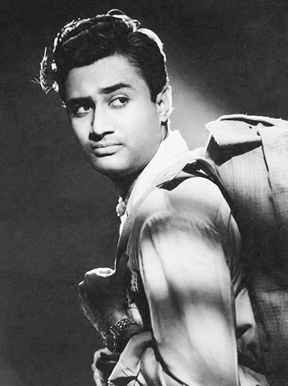
In the last few years, much has been written about two rare and lesser-seen films of Dev Anand made in English, also featuring other renowned Indian actors in the cast. These include The Guide directed by Tad Danielewski released in 1965 and The Evil Within directed by Lamberto V. Avellana released in 1970. Unfortunately, both the attempts couldn’t influence the viewers in the west and were declared unsuccessful ventures despite many known international names associated with their making.
Widely quoted as the two English films of Dev, in reality, they came years after K.A. Abbas’s Rahi, which was also made in English (as a bilingual) with Dev Anand, Nalini Jaywant, Balraj Sahni, and David playing the key roles. Rahi was simultaneously made in English with the title of The Wayfarer in 1952 (minus the songs), more than a decade before Guide’s English version.
Based on Mulk Raj Anands’ novel ‘Two Leaves and a Bud’, Rahi was a social drama produced and directed by K. A. Abbas (who also wrote the dialogues) under the banner of Naya Sansar. The film’s Hindi version had music by Anil Biswas and lyrics by Prem Dhawan. Based in Assam of 1945, its story revolved around a young, jobless, ex-army man (played by Dev), who agrees to do the job of a labour supervisor offered by British owners of a tea estate. The character had negative shades (in the early part of the film) as it involved managing the workers maintaining strict discipline, also using a whip. A few tragic events in the story progression transform the protagonist and he soon realizes what he needs to do to support the poor and helpless workers going against his employers. The film had a gripping as well as shocking climax where the workers revolt against the estate owners along with Dev, and it certainly was a risky, unconventional, and brave attempt made in the early ‘50s talking about labour exploitation.
Coming to the film’s English version, there is an interesting story behind its conception as a bilingual. As expressed by Abbas,
“It was made in Hindustani and English – for since I had seen films like Ganga Din with American actors playing the roles of Indians. I wanted to have my revenge by making Indians play English characters. Hence Balraj Sahni was the English doctor, a sympathetic character, and Kate Sethi, an Englishwoman married with an Indian, was his beloved.” This also explains the reason Balraj Sahni speaks with an English accent, even in the Hindi version of the film.
Rahi’s English version also faced problems when it was sent for release in England. In the director’s words,
“The English version could not be shown in England due to the agitation launched by the British planters in India. They wrote to the Prime Minister of India asking for a ban on it in India, too, in the interest of Commonwealth unity. I met the PM and he asked his secretary in my presence, what was the reply when India had launched a similar protest against anti-Indian American films running in England, and he said, ‘They wrote England is a free country and, subject to normal censorship, any picture could be shown.’
‘Then repeat the same message to them’, the Prime Minister ordered his secretary, and there the matter rested.”
Talking about the film’s unusual climax, the director had his doubts as he said, “I was assured that the picture would have been a hit – but for its tragic end. But I couldn’t change the end and so the picture cost us about a lakh in losses”.
Dev remembers the film while writing about his six-week trip to the Soviet Union in his autobiography, and he says, “Two films I starred in, Aandhiyan and the English version of Rahi, directed by K. A. Abbas, were official entries at the film festival”. He later adds how the Russians raised a toast for his performance in the film on his thirty-first birthday during a large cocktail-cum-dinner reception. Reportedly, a dubbed Russian version, was also released in the USSR called Ganga – the name of Nalini Jaywant’s character in the film.
Unfortunately, the print of The Wayfarer – the English version of Rahi, is not to be found anywhere online, feared to be probably lost forever. Even the Hindi version uploaded is of just two hours of duration, whereas the original film is of 139 minutes as per the Encyclopaedia of Indian Cinema.
Interestingly, the list of Dev’s English films does not end at three, as there was an English version of his Teen Devian too, that was ghost-directed by himself as declared in his autobiography. It was titled Oh Boy and Three Girls, but will keep that for another column on Dev in the coming weeks.
Cheers!
Bobby Sing
bobbytalkscinema.com
NOTE : The article was first published in THE FREE PRESS JOURNAL Newspaper (Mumbai Edition) on 18th April 2021.
Note : The write-up is a chapter shared from my upcoming book releasing soon. So any additions, rectifications suggested by friends are welcome to make it better.
----------
 For more such interesting articles on lesser known facts on Hindi Cinema, do try DID YOU KNOW
For more such interesting articles on lesser known facts on Hindi Cinema, do try DID YOU KNOW Series by
Bobby Sing available in both
Book and
E-book form
.
Also available
at Notionpress and Flipkart stores (in India)
The book is now also available in Hindi titled ITNA TO YAAD HAI MUJHE published by Prabhat Prakashan
Available at all leading portals online.


 For more such interesting articles on lesser known facts on Hindi Cinema, do try DID YOU KNOW Series by Bobby Sing available in both Book and E-book form.
For more such interesting articles on lesser known facts on Hindi Cinema, do try DID YOU KNOW Series by Bobby Sing available in both Book and E-book form.